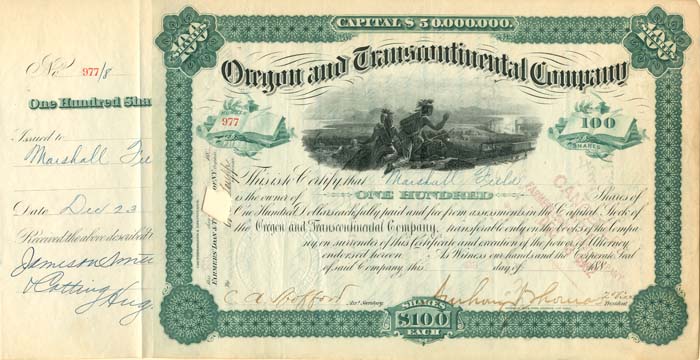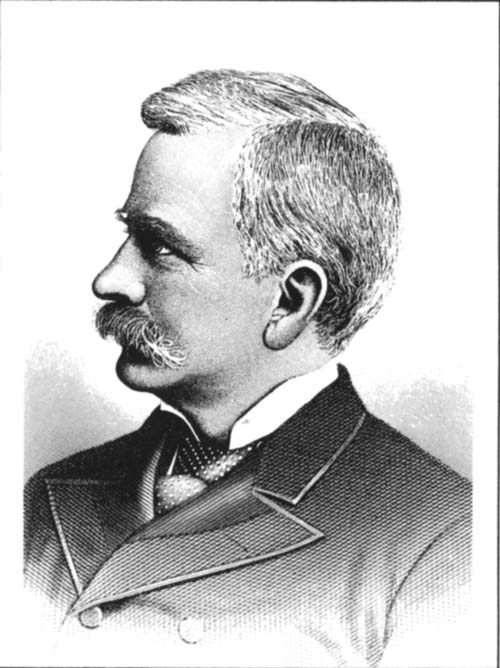Oregon and Transcontinental Co. signed by Marshall Field - Autograph Stock Certificate
Inv# AG1753 Stock
Stock signed by Marshall Field on back and printed by American Bank Note Company, New York. Portrait and biography included.


The Oregon and Transcontinental Company was a 19th-century holding company in the United States, organized by Henry Villard in 1881 to control the Northern Pacific Railroad and Oregon Railway and Navigation Company. It was incorporated in Oregon. New Jersey passed legislation in 1889 to facilitate the control of other companies by another corporation with a goal of encouraging trusts to convert into holding companies and relocate to that state. Oregon and Transcontinental in 1890 re-incorporated as a holding company in New Jersey and became the North American Company so that it could take advantage of these expanded corporate powers and invest in a wider range of businesses.
Marshall Field (August 18, 1834 – January 16, 1906) was an American entrepreneur and the founder of Marshall Field and Company, the Chicago-based department stores. His business was renowned for its then-exceptional level of quality and customer service.
Field is also known for some of his philanthropic donations, providing funding for the Field Museum of Natural History and donating land for the campus of the University of Chicago.
Marshall Field was born on a farm in Conway, Massachusetts, the son of John Field IV and wife Fidelia Nash. His family was descended from Puritans who had come to America as early as 1650.
At the age of 17, he moved to Pittsfield, Massachusetts, where he first worked in a dry goods store alongside his brother Joseph Field. He left Massachusetts after five years of working in the dry goods store in search of new opportunities in the rapidly expanding West. In 1856, at age 22, he went to live with his brother in Chicago, Illinois, and obtained employment at leading dry goods merchant Cooley, Wadsworth & Co., which was to become Cooley, Farwell & Co. in 1857.
Field quickly rose through the ranks of Cooley, Farwell & Co. In 1862 for financial reasons Cooley left the firm. That same year Field purchased a partnership and the firm reorganized as Farwell, Field & Co. John V. Farwell appreciated Field's keen business acumen; however, when it came to personality, the two were very different. Field's stuffy efficiency rode on Farwell's more relaxed and cheery demeanor. At a time when business collaboration entailed extensive personal interaction, this partnership would not last long.
In January 1865, Field and a partner, Levi Leiter, accepted an offer to become senior partners at the dry goods establishment of Potter Palmer. The new firm became known as "Field, Palmer, Leiter & Co." In 1867, after Field and Leiter could afford to buy him out, Palmer withdrew from the firm, and it was renamed "Field, Leiter & Company." In 1867 Field, Leiter & Company reported revenues of $12 million. Like many Chicago businessman, Field's company was badly affected by the Great Chicago Fire of 1871, but reopened relatively quickly. The company also survived the Panic of 1873 because of their relatively low levels of debt. By 1881 Field had forced Leiter to sell his share of the business, and changed the store's name to "Marshall Field and Company".
Field took an early 19th-century consumer landscape that was centered around the principle of caveat emptor, or "buyer beware", and transformed it into a plush shopping experience fit for the Gilded Age. Unconditional refunds, consistent pricing and international imports are among the Field innovations that became standards in quality retailing. Field's employees were also instructed not to push products on uninterested customers as was common practice in stores of the period. The quotes "Give the lady what she wants" and "The customer is always right" are attributed to Field.
Though most famous today for his retail business, during his lifetime his wholesale business made far more money. During the 1880s, Field's wholesale business generated five times more revenue than retail annually. The wholesale business even had its own landmark building, the Marshall Field's Wholesale Store, erected in 1887. Revenue from the Marshall Field's retail business did not surpass the company's wholesale business until after Field's death.
Field was highly suspicious of organized labor throughout his career, and prohibited unionization among his employees. During the time of the Haymarket Riot, the wives of the defendants initiated an appeal, to which all of the local businessmen agreed except for Field. Journalist and reformer Henry Demarest Lloyd led a national campaign to grant clemency. Even bankers like Lyman J. Gage favored clemency, believing that moderation would lead to improved relations between capital and labor. Potter Palmer and Charles L. Hutchinson were inclined to agree, but Marshall Field was not. A number of other men confided to Gage that they were not willing to publicly disagree with Field, the wealthiest and most powerful businessman in Chicago. Field would also oppose organized labor during the Teamster's Strike in 1905.
Field avoided political and social intrigue, instead focusing on his work and on supporting his family and his favorite philanthropies. Field was a very active member of the Commercial Club and the Jekyll Island Club aka the Millionaires Club on Jekyll Island, Georgia.
Field married twice. In 1863, he married Nannie Douglas Scott of Ironton, Ohio. They had two sons and a daughter, but one son, Louis, died in 1866 as an infant. The surviving children were Marshall Field Jr. and Ethel Field. Their son, Marshall Jr. (1868–1905), married Albertine Huck, and they were the parents of Gwendolyn Mary Field, who married Sir Archibald Charles Edmonstone, 6th Baronet. Field's Ethel was married twice: first to Arthur Magie Tree, to whom she bore one son, Ronald Tree, and then in 1901 to David Beatty, 1st Earl Beatty, to whom she bore two sons, David Beatty, 2nd Earl Beatty and Peter.
After the death of his first wife Nannie in 1896, Field married longtime friend Delia Spencer, widow Canton. They had no children together.
Field died in New York City, New York, on January 16, 1906, at age 71 of pneumonia contracted after playing golf on New Year's Day with his nephew, his secretary and Abraham Lincoln's eldest son Robert Todd Lincoln. Field was buried on January 19 in the Graceland Cemetery in Chicago.
After his death, Field's estate was to be held in trust for 40 years for his two grandsons, Henry Field and Marshall Field III. In 1905, Field's fortune was valued at $125 million. Henry Field died in 1917 and was thus unable to collect his inheritance, leaving the Field fortune in the hands of Marshall Field III.
The Field Museum of Natural History was named after him in 1894 after he gave it an endowment of one million dollars. Field was initially reluctant to do so, reportedly saying "I don't know anything about a museum and I don't care to know anything about a museum. I'm not going to give you a million dollars." However he later relented after railroad supplies magnate Edward E. Ayer, another early benefactor (and later first president) of the museum, convinced Field that his everlasting legacy would be achieved by financing the project. The year after his death the Field Museum received a further $8,000,000 in accordance with his will.
The University of Chicago was founded by both Field and New York's John D. Rockefeller, to rival nearby Evanston's Northwestern University.
A bust of Marshall Field stands aside other early 20th century Chicago industry magnates on the north riverbank on the Chicago River facing the Merchandise Mart.
A stock certificate is issued by businesses, usually companies. A stock is part of the permanent finance of a business. Normally, they are never repaid, and the investor can recover his/her money only by selling to another investor. Most stocks, or also called shares, earn dividends, at the business's discretion, depending on how well it has traded. A stockholder or shareholder is a part-owner of the business that issued the stock certificates.










Ebay ID: labarre_galleries